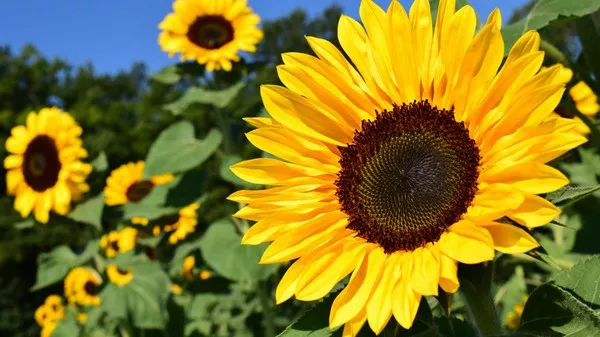Sunflowers (Helianthus annuus) are renowned for their striking appearance and nutritious seeds. However, beyond the seeds and petals lies another part of the sunflower plant that often goes unnoticed – the leaves. While many people focus solely on the seeds, it prompts the question: can you eat sunflower leaves? In this article, we delve into the edibility of sunflower leaves, exploring their nutritional content, potential health benefits, and culinary uses.
Understanding Sunflower Leaves
Sunflower leaves are the green, elongated structures that grow from the stem of the sunflower plant. They typically have a rough texture and serrated edges, with a distinct veining pattern. Sunflower leaves vary in size, with mature plants producing larger leaves that can measure several inches in length and width.
Edibility of Sunflower Leaves
1. Are Sunflower Leaves Edible?
Yes, sunflower leaves are edible, but their palatability and desirability can vary depending on the plant’s age and the individual’s taste preferences. Younger sunflower leaves tend to be more tender and flavorful, while older leaves can be tougher and more bitter.
2. Are Sunflower Leaves Safe to Eat?
Generally, sunflower leaves are safe to eat for most people when consumed in moderation. However, it’s essential to ensure that the leaves are free from pesticides, herbicides, or other contaminants that may be present if grown in non-organic conditions.
3. Nutritional Content of Sunflower Leaves
Sunflower leaves contain a range of nutrients, including vitamins, minerals, and phytochemicals. While specific nutrient levels may vary based on factors such as soil quality and growing conditions, sunflower leaves typically provide:
- Vitamins: Sunflower leaves are rich in vitamins A, C, and K, which are essential for maintaining healthy vision, supporting the immune system, and promoting blood clotting.
- Minerals: They contain minerals such as calcium, magnesium, and iron, which are important for bone health, muscle function, and oxygen transport in the body.
- Phytochemicals: Sunflower leaves contain various phytochemicals, including flavonoids and chlorogenic acid, which have antioxidant properties and may help reduce inflammation.
Health Benefits of Eating Sunflower Leaves
1. Antioxidant Properties
Sunflower leaves contain antioxidants such as flavonoids and chlorogenic acid, which help neutralize harmful free radicals in the body. Consuming foods rich in antioxidants may help reduce the risk of chronic diseases such as heart disease, cancer, and neurodegenerative disorders.
2. Anti-Inflammatory Effects
Some compounds found in sunflower leaves have anti-inflammatory properties, which may help alleviate symptoms of inflammatory conditions such as arthritis, asthma, and inflammatory bowel disease.
3. Nutrient Density
Sunflower leaves are nutrient-dense, meaning they provide a wide range of essential nutrients relative to their calorie content. Incorporating nutrient-dense foods like sunflower leaves into your diet can help ensure you meet your daily nutritional requirements.
4. Digestive Health
The fiber content in sunflower leaves can promote healthy digestion by adding bulk to stool, preventing constipation, and supporting the growth of beneficial gut bacteria.
Culinary Uses of Sunflower Leaves
1. Raw Consumption
Young, tender sunflower leaves can be eaten raw and added to salads for a fresh, crunchy texture. They can also be incorporated into wraps or sandwiches for added nutrition.
2. Cooked Dishes
Older sunflower leaves, which may be tougher and more bitter, can be cooked to soften their texture and mellow their flavor. They can be sautéed with garlic and olive oil or added to soups, stews, and stir-fries for a nutritious boost.
3. Smoothies and Juices
Sunflower leaves can be blended into smoothies or juices along with other fruits and vegetables to create nutrient-rich beverages. This is an excellent way to incorporate sunflower leaves into your diet if you find their flavor too strong when consumed alone.
4. Tea
Sunflower leaf tea can be made by steeping dried sunflower leaves in hot water. This herbal tea may have a slightly bitter flavor but can be sweetened with honey or flavored with lemon for added taste.
Harvesting and Preparing Sunflower Leaves
1. Harvesting
When harvesting sunflower leaves for consumption, choose young leaves from healthy, pesticide-free plants. Harvest leaves in the morning when their moisture content is highest for optimal freshness.
2. Cleaning
Thoroughly wash sunflower leaves under cold running water to remove any dirt, debris, or pests. Pat the leaves dry with a clean kitchen towel or allow them to air dry before use.
3. Storage
Store freshly harvested sunflower leaves in the refrigerator in a plastic bag or airtight container to maintain freshness. Use them within a few days for the best flavor and texture.
4. Processing
If desired, sunflower leaves can be blanched in boiling water for a few seconds to soften them slightly before incorporating them into cooked dishes. Alternatively, you can freeze sunflower leaves for longer-term storage and use them as needed.
Conclusion
Sunflower leaves are not only edible but also offer a range of potential health benefits due to their nutrient content and antioxidant properties. Whether eaten raw in salads, cooked in savory dishes, or blended into beverages, sunflower leaves can be a versatile addition to your diet. However, it’s essential to ensure that the leaves are harvested from pesticide-free plants and prepared properly before consumption. By incorporating sunflower leaves into your meals, you can enjoy their unique flavor and reap the nutritional rewards they offer.


